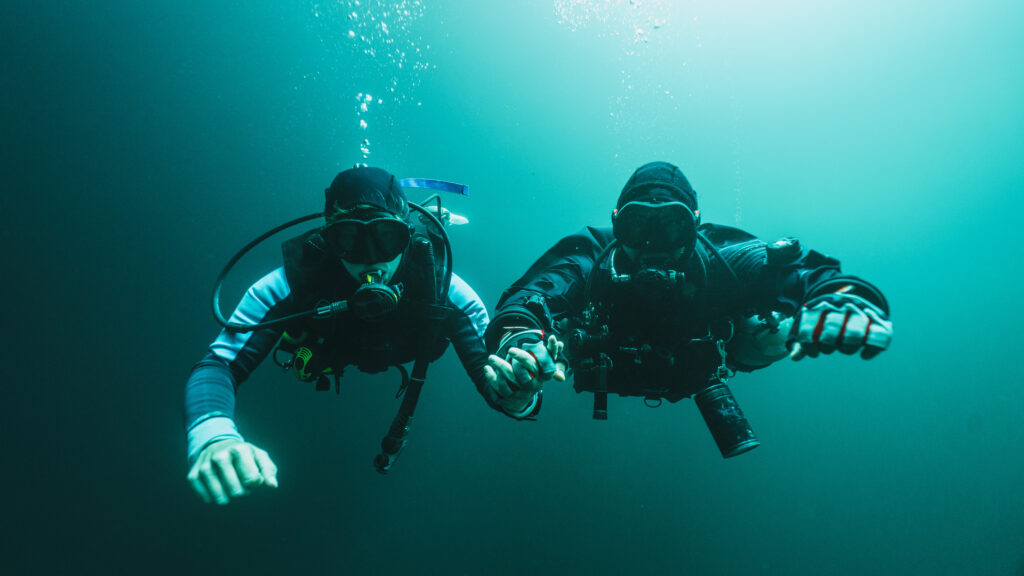What is Sidemount Diving?

Sidemount diving is a scuba equipment configuration where diving cylinders are placed along the diver’s sides rather than on the back, as is typical in traditional backmount setups. This system allows for enhanced flexibility, mobility, and safety while underwater. The cylinders are positioned below the shoulders and extend along the hips, giving divers more freedom of movement compared to conventional systems. Divers appreciate sidemount configurations for their ability to streamline the diver’s profile, which is particularly advantageous in environments with tight spaces like caves, but the setup is also widely used in other forms of diving, from recreational to professional.
What is Reserve Gas in Scuba Diving?

What is Reserve Gas in Scuba Diving? Reserve Gas, a term of paramount importance in the world of scuba diving, refers to a portion of gas supply that a diver sets aside exclusively for emergency situations. It is an integral part of the diving planning and execution process. This reserve is not meant to be […]
What is a Regulator Freeze when Scuba Diving?

What is a Regulator Freeze when Scuba Diving? Scuba diving is a popular underwater recreational activity that allows divers to explore the underwater world. A crucial component of scuba diving equipment is the regulator, which delivers breathing gas from the tank to the diver at a safe and comfortable pressure. One of the potential hazards […]
What is Carbon Dioxide (CO2)?

What is Carbon Dioxide (CO2)? Carbon dioxide (CO2) is an odorless, tasteless gas that is a natural byproduct of metabolism. This greenhouse gas plays a crucial role in the Earth’s atmosphere, and it is also an essential factor to consider for scuba divers. Exhaled by the lungs, CO2 is a critical aspect of scuba diving, […]
What is Buoyancy in Diving?

Buoyancy, a fundamental principle in fluid mechanics, plays a crucial role in scuba diving, affecting everything from a diver’s comfort and safety to underwater navigation and marine life observation. Understanding and controlling buoyancy is essential for divers to achieve the perfect underwater experience.
What is a Buddy Check?

What is a Buddy Check? A buddy check is an essential safety procedure in scuba diving, designed to ensure that both the diver and their dive buddy are fully prepared and equipped for their underwater adventure. This 1000-word entry will provide a comprehensive overview of the buddy check process, its importance, the key steps involved, […]
What is Buddy Breathing?

What is Buddy Breathing? Buddy breathing is a vital emergency procedure in scuba diving that involves the sharing of a single air supply by two or more divers when one diver’s air supply is exhausted or unavailable due to equipment malfunction. This life-saving technique is an essential component of scuba diving training and serves as […]
What is a Buddy when Scuba Diving or Freediving?

A “buddy” in scuba diving or freediving refers to a designated diving partner who accompanies another diver during their underwater experience. The buddy system, a central part of these activities, was designed to enhance safety and promote teamwork. The buddy concept involves two divers working together, keeping an eye on each other, and offering help when necessary. This system is critical for ensuring that both individuals have a safe and enjoyable time underwater.
What is a Balanced Regulator?

What is a Balanced Regulator? A balanced regulator is an essential piece of scuba diving equipment designed to help divers maintain a consistent breathing effort regardless of external conditions, such as depth or tank pressure. This innovative device ensures that the diver receives an optimal and smooth air supply throughout the dive, significantly enhancing their […]
What is Arterial Gas Embolism (AGE) from Scuba Diving?

What is Arterial Gas Embolism (AGE) from Scuba Diving? Arterial gas embolism (AGE) is a type of decompression illness that occurs in scuba diving, characterized by the formation of gas bubbles in the arterial blood supply. This serious condition can result from trapped air expanding in the lungs, causing ruptures and barotrauma. AGE can have […]
